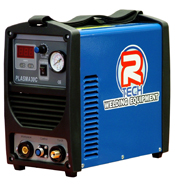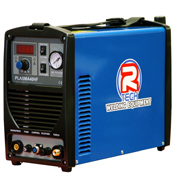
Plasma CuttersRead what an ex-user of Miller Machines has to say!
The R-Tech P50HF is a heavy duty machine with a massive 18mm genuine clean cut, high
frequency arc starting, pilot arc re-start and cost effective - long life consumables R-Tech Welding Machines Compare with Lincoln and Miller but don't cost as much! For great products at great prices, call us on +27 11 784 0171 or email: sales@weld-tech.co.za Or email deon@weld-tech.co.za for technical queries. WE SHIP TO THE FOLLOWING COUNTRIES: BOTSWANA, ZAMBIA, NAMIBIA, ZIMBABWE, MOZAMBIQUE, ANGOLA. PLUS ANY OTHER COUNTRY IN AFRICA. Please note: Prices are Subject to Change
AN EXPLANATION OF THE PROCESS
Plasma cutting is a process that is used to cut steel and other metals of different thicknesses (or sometimes other materials) using a plasma torch. In this process compressed air is blown at high speed out of a nozzle; at the same time an electrical arc is formed through that gas from the nozzle to the surface being cut, turning some of that gas to plasma. This is sufficiently hot to melt the metal being cut and moves sufficiently fast to blow molten metal away from the cut.. HOW IT WORKS?The HF Contact type uses a high-frequency, high-voltage spark to ionise the air through the torch head and initiate an arc. This requires the torch to be in contact with the job material when starting, not sp good if you have to penetrate through things like rust or painted surfaces. The Pilot Arc type uses a two cycle approach to producing plasma, avoiding the need for initial contact. First, a high-voltage, low current circuit is used to initialize a very small high-intensity spark within the torch body, thereby generating a small pocket of gas. This is referred to as the pilot arc. The pilot arc has a return electrical path built into the torch head. The pilot arc will maintain itself until it is brought into proximity of the workpiece where it ignites the main cutting arc. These arcs are extremely hot and are in the range of 15,000 degrees Celsius. Plasma is an effective means of cutting thin and thick materials alike. Hand-held torches can usually cut up to 2 in (48 mm) thick steel plate, and stronger computer-controlled torches can pierce and cut steel up to 12 inches (300 mm) thick. Formerly, these cutters could only work on conductive materials; however, new technologies allow the plasma ignition arc to be enclosed within the nozzle, thus allowing the cutter to be used for non-conductive workpieces such as glass and plastics. Since plasma cutters produce a very hot and very localized "cone" to cut with, they are extremely useful for cutting sheet metal in curved or angled shapes. WHAT IS AN INVERTER CUTTER?Inverter cutters
rectify the mains supply to DC, which is fed into a high-frequency transistor inverter between 10kHz to about
200kHz. Higher switching frequencies give greater efficiencies in the transformer, allowing its size and weight
to be reduced. Today's power modules are called IGBT's (Inter Gate Bipolar Transistors) and are generally found
in better quality machines. IGBT based machines operate more efficiently and reliably. CHOOSING THE RIGHT ONE?The best way to decide which model is going to be right for you is to consider the thickness of metal you intend to cut. We are always honest in what we claim our machines will cut. We quote the clean cut depth as a benchmark for cutting thickness. This will mean that the maximum, or severance cut, will be 20 -25% higher then the clean cut measurement. Severance cuts on most machine will normally require some finishing on the cut edge due to the cutter operating at the upper most limit of it's operational envelope. |
|




















